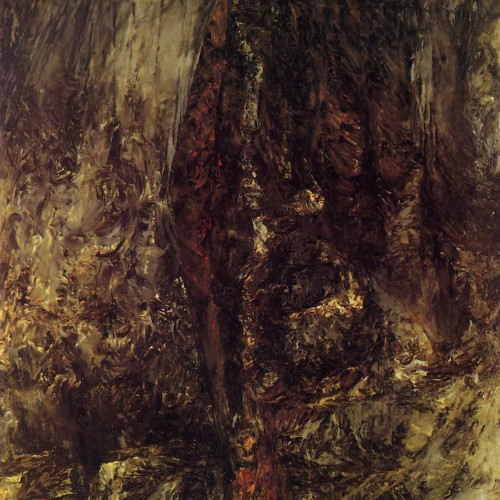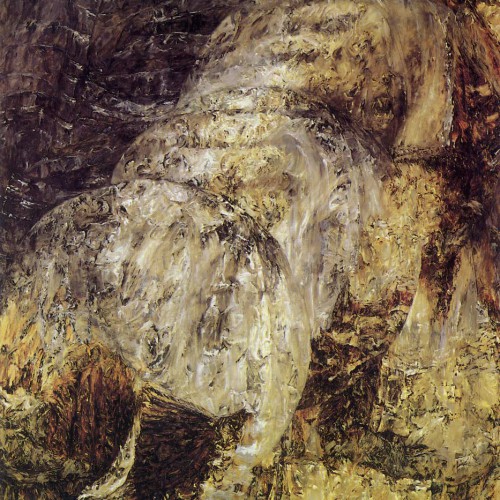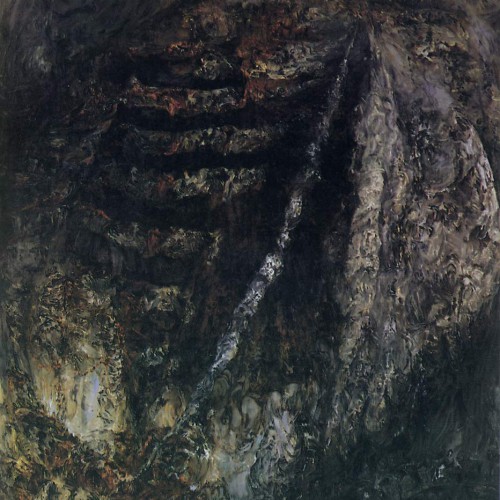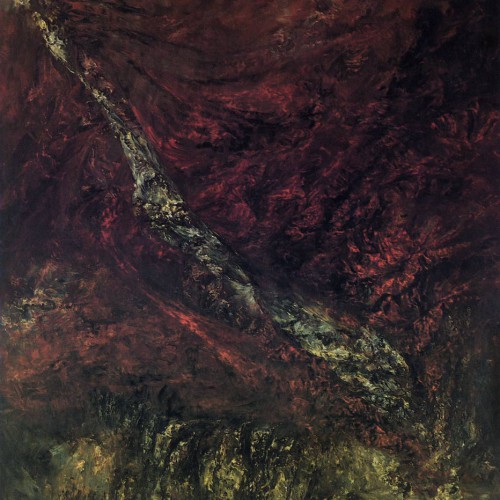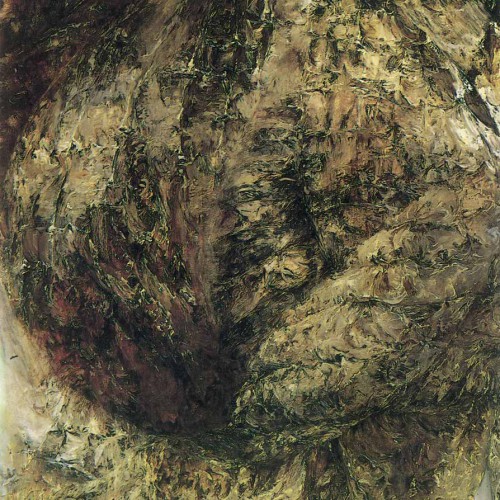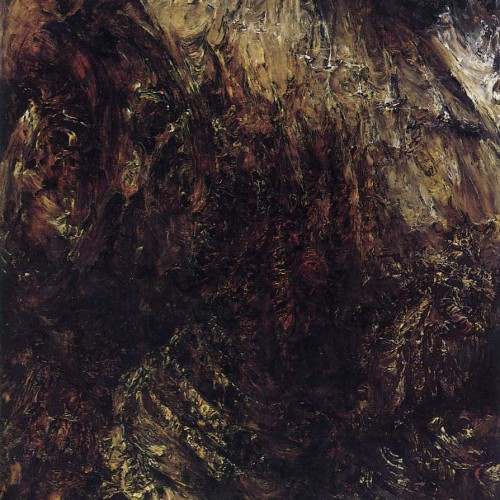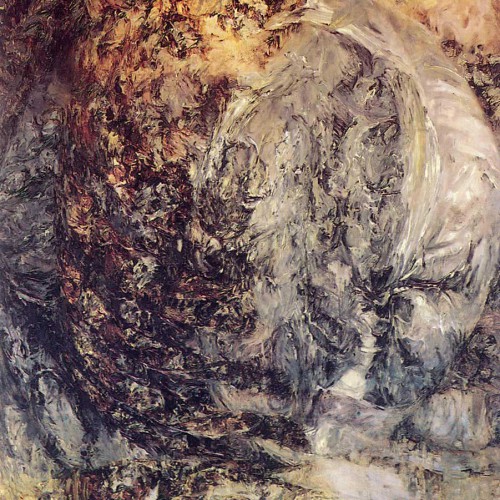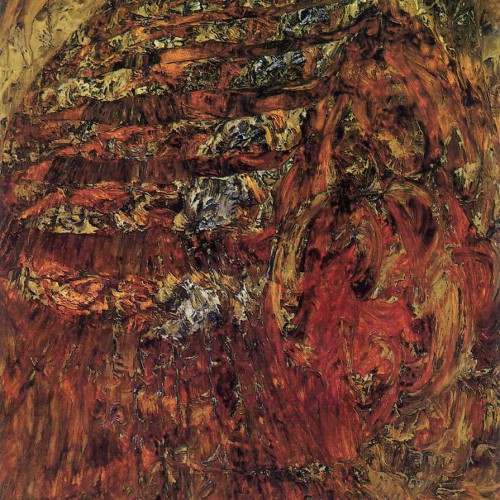Stuart Morgan’s essay, first published in the exhibition catalogue for Letters to Rose at Galerie Krinzinger, Vienna, 1986.
- Taking Sides, 1986
- Cast, 1986
- Spinner, 1986
- Rose Cross, 1986
Clinging with difficulty to what seems to be a slippery canvas is paint which has been subjected to a variety of small moves. Its direction is unpredictable. So is the colour; any single stroke has others threaded into it, so that it seems to be changing even at the moment of vision. Space buckles and advances without warning. The relation between individual strokes and the structures they seem to suggest proves uneasy; grand designs arise only to disintegrate again. And the very nature of these structures remains in doubt; the virtuosity of the performance lies in a persistent refusal to lapse into illusionism. Thérèse Oulton’s first proposition seems obvious: for her, painting involves a series of refusals.
Her second proposition is equally important: style is a machine for procrastinating. Improvisation can be used to preserve the freedom of painting, like a child inventing endless excuses not to have to go to bed. Oulton speaks knowingly of Bach’s Art of the Fugue experiments, in which the sense of a “home” key has been lost but where that loss leads to a less tethered existence, a perpetual hovering without resolution. Her own style travels far from “home”. Most successful when least constrained, it yearns to be free of its enabling support, an effect heightened in the latest paintings by the presence of areas quite devoid of impasto, ratifying, not repudiating, her former metaphor of painting as woven fabric.
The confidence with which a term like “style” can be used implies aestheticism – “pure” virtuoso painting for its own sake. No description of Thérèse Oulton’s strategy could be more inaccurate. Her training was from abstract painters. Instead of rejecting their attitude out of hand, she extended it. Most importantly, she examined her premises. Like that of other British post-conceptual painters, her modus operandi is the result of a revised view of painting following a widespread loss of faith in its powers. Artists such as Christopher LeBrun or Steven Campbell began by isolating painting’s components and assumptions, then subjecting them to scrutiny before reassembling them – not necessarily in the same order or with the same significance. Artaud wrote of “Theatre and its Double”. This reconstituted art of the 1980s was the “double” of painting. When, in Thérèse Oulton’s work, a constituent of classic art such as chiaroscuro exists without reference to the object which might have occasioned it, its use cannot but evoke the shadow of classic painting which it has forsaken. Yet the result is not nostalgia for the possibility of renewed faith in outdated means. Still less is it a meditation on the decline of the West. It is a re-engagement with painting divested of sentimentality, spurious authority, bogus authenticity and hocus-pocus. Oulton’s project is at once an exercise in distantiation, with all the associations of starting from scratch which that entails, and the construction of a model for a subversive art. Hence the title “Letters to Rose”, a reference to the lost history of women through the ages, to the sense of intimate community and the thought of setting things to rights. The determination to step aside from arguments and remain aside, to renew oneself automatically, to make paintings which hang suspended between negative paradoxes (“neither this nor that”), to envisage immanence and potentiality, suggests the cluster of problems which is both her subject and her situation, as a woman and an artist: the need to formulate a rejection of what is known, as a leap of faith which in itself might be the stimulus for creating a new language. One aspect of this might be the deliverance of the body. (“Rose”, as Marcel Duchamp knew, is an anagram of Eros). Another might be the reappraisal of pleasure, drawn from play within the perimeters of the act of painting itself. A third might be the rethinking of labour, of a work of art regarded as a work of work, and related to this the renunciation of the simplistic aesthetic belief in “expressionism”, regarding the artwork instead as an artifact. Hints of a new order are everywhere in Oulton’s work. References to alchemy are frequent, as is the visual pun which connects rock or mud with gold, or just the flash of gold in sunlight: if not the real, then at least the visually perceptible riches hidden at the centre of the earth. Yet these are another alternative faith (or invented alternative to faith) which hoped for a bright future when the dead wood of Christ’s cross would flower. But what if the metaphor of regeneration was unfounded in both cases? Could it be that each was an elaborate method of encouraging people to re-assess their position, to see the world as it is and not as they would want it to be? In other words, to abandon the “rose-tinted spectacles” of religion?
- Dissonance Quartet No. 1, 1985
- Dissonance Quartet No. 2, 1985
Thérèse Oulton’s letters to Rose recommend just that. The main mark of her work, seen at its most expert in a series such as the Dissonance Quartet, is an ability to frustrate any reading of her painting, to force viewers to ransack their visual repertoire and to employ various, often mutually exclusive, types of interpretation simultaneously on one picture. So Dissonance Quartet 2 could be read as a tidal wave overwhelming a city, or as an “abstraction”. The painting is therefore able to combine, if not to heal, contradictions by situating itself between them and summoning both at once. It is an ideal state of affairs, which Oulton with her unusual ability to rehearse her philosophical dilemmas in her art, has tried to utilise. Many of her paintings have evoked subterranean images, for example, because according to the separation orthodox religion made between matter and spirit, a division it had a vested interest in preserving, the earth exists in opposition to the world above, a world on which it is proper to fix one’s attention – to the detriment, it might be argued, of one’s well-being here below.
- Dissonance Quartet No. 3, 1986
- Dissonance Quartet No. 4, 1986
In the bowels of the earth the densest forms of material, such as fossils, flout the matter versus spirit debate by containing their own light and even emitting it in their own unpleasant way, which Oulton recalls in Cast. Her recent desire to show the outsides and insides of things at the same time, with skin and ribs in full view as if the object had been flayed or disembowelled, constitutes another impossibility which can be demonstrated in painting but nowhere else. It is in keeping with her technique of perpetual elaboration that each new advance resembles a variant of the first: that dual visual reading which characterises her work, and from which the entire career, a career of remarkable poetic consistency, begins. Duplicity also underlies the “Letters to Rose”. They may be about heresy, they may be about the strength required to divest oneself of outworn beliefs before the advent of an new order, but primarily they are about looking, painting and thinking, but more particularly the connection between the three – a connection which impels Thérèse Oulton herself. And finally, the letters do turn out to be subversive, precisely because they are available for everyone to see. They are subversive as only an open secret can be.
